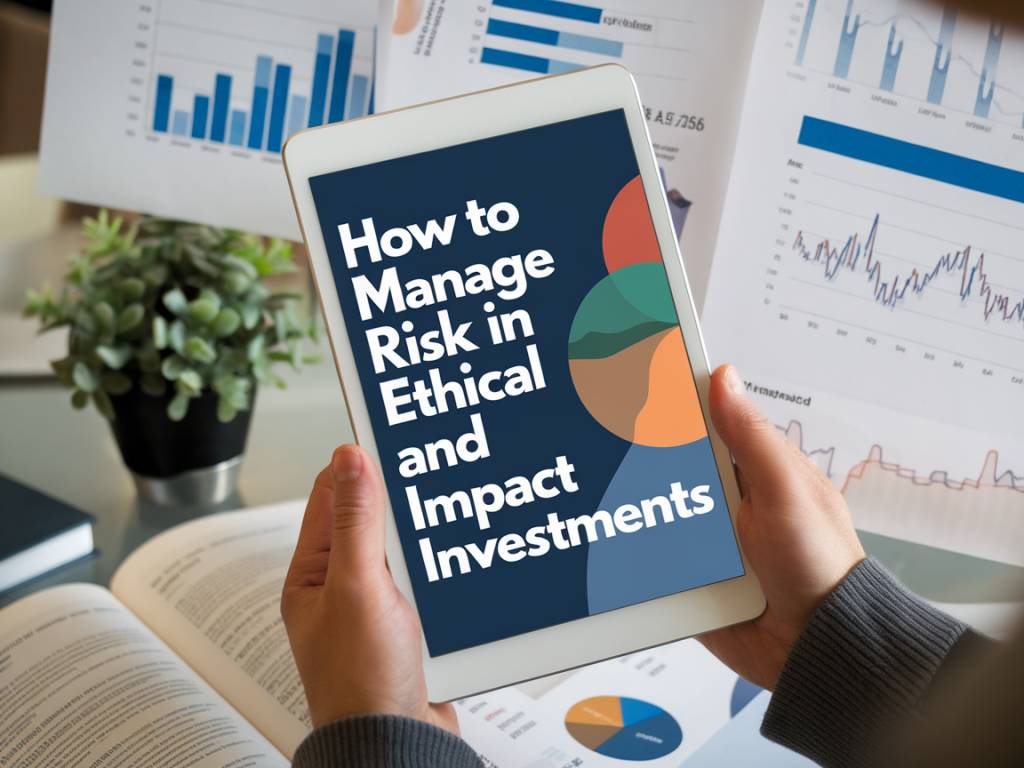Investing ethically and with a focus on impact has become a priority for many individuals and organizations. While the goal is to generate social and environmental benefits alongside financial returns, it is crucial to manage the associated risks effectively. Through this article, I will offer practical advice, concrete examples, and highlight relevant case studies, ensuring you are equipped to navigate this field adeptly.
Understanding Ethical and Impact Investments
Ethical investments, also known as socially responsible investments (SRI), involve selecting stocks, bonds, or funds based on ethical guidelines. These guidelines can include environmental sustainability, social justice, corporate governance, and more. Impact investments go a step further, actively seeking to generate measurable social or environmental impact along with financial returns.
Both investment strategies share common principles but differ in their intensity and specificity. While ethical investing often relies on screening criteria to exclude or include certain investments, impact investing aims for proactive and measurable contributions to societal goals.
Identifying Key Risks in Ethical and Impact Investments
Like any investment, ethical and impact investing carries its risks. However, these can be categorized into specific types that are particularly relevant to this sector.
Reputation Risk: Investors might face reputational damage if the companies or projects they support are found to engage in activities that contradict ethical or impact objectives. For example, a renewable energy company might be using environmentally harmful extraction processes.
Performance Risk: Ethical investments may sometimes underperform compared to traditional investments, especially if the focus on ethics excludes high-yield sectors.
Impact Measurement Risk: Determining the actual social or environmental impact of investments can be challenging. Investors might face discrepancies between expected and actual outcomes.
Implementing a Risk Management Plan
Effective risk management in ethical and impact investing involves a multifaceted approach. Here are the steps you can take to mitigate risks:
1. Conduct Thorough Due Diligence:
Before making any investment, it’s essential to conduct a detailed analysis of the company or project. This includes not only financial performance but also adherence to ethical guidelines and their impact track record. For instance, reviewing sustainability reports, third-party audits, and stakeholder reviews can provide insights into potential risks.
2. Diversify Investments:
Diversification is a universal risk management strategy. In the context of ethical and impact investing, spreading investments across different sectors, geographies, and projects can minimize risk. For example, combining investments in renewable energy, sustainable agriculture, and fair trade companies can balance potential underperformance in one area.
3. Engage in Active Ownership:
As an investor, engaging with the companies you invest in through voting, dialogues, and even direct engagements can influence their operations and strategies positively. Active ownership ensures that companies remain aligned with ethical standards and impact goals.
4. Monitor and Evaluate Impact:
Regularly assessing the social and environmental impact of your investments is crucial. Utilizing standardized impact measurement frameworks such as the Global Impact Investing Network’s (GIIN) Impact Reporting and Investment Standards (IRIS) can help track progress and mitigate measurement risk.
5. Stay Updated with Regulations and Policies:
The landscape of ethical and impact investing is continuously evolving, with new regulations and policies shaping how investments are made and measured. Staying informed about these changes can help in adapting strategies and minimizing compliance risks.
6. Collaborate with Experts:
Partnering with organizations, advisors, and consultants who specialize in ethical and impact investing can provide valuable insights and risk management strategies. These experts can offer guidance on best practices and emerging trends.
Case Studies: Successful Risk Management in Ethical Investing
Examining real-world examples can offer practical insights into how risks are managed successfully in ethical and impact investing.
The Calvert Social Investment Fund:
One notable example is the Calvert Social Investment Fund. Established in 1982, it has become a leader in ethical investing by incorporating rigorous social and environmental screens while seeking competitive financial returns. The fund’s success lies in its robust due diligence process, ongoing impact assessments, and active shareholder advocacy. For instance, Calvert actively engages with companies to promote sustainable practices, addressing potential reputation risks early on.
Triodos Bank:
Triodos Bank, based in the Netherlands, exemplifies impact investing by directly financing projects with positive societal impacts. The bank’s comprehensive risk management approach includes a stringent evaluation of the projects’ financial viability and impact potential. By focusing on transparency and stakeholder engagement, Triodos mitigates performance and impact measurement risks effectively.
Recommendations for Aspiring Ethical and Impact Investors
For those looking to embark on ethical and impact investing, here are actionable steps to get started:
1. Define Your Ethical and Impact Goals:
Begin by clearly articulating what ethics and impact mean to you. Identifying whether your focus is on environmental sustainability, social equity, or governance will guide your investment choices and risk management strategies.
2. Start Small and Learn:
If you are new to ethical and impact investing, start with a small portion of your portfolio and gradually increase as you become more confident. This approach allows you to learn and adapt without exposing yourself to significant risks.
3. Utilize Ethical Investment Platforms:
Many platforms and mutual funds specialize in ethical and impact investments, providing a curated selection that aligns with specific ethical criteria. Leveraging these platforms can simplify the initial investment process.
4. Engage with Community and Networks:
Joining communities and networking with other ethical and impact investors can provide support, share knowledge, and keep you updated on emerging trends and best practices.
5. Regularly Review and Adjust Your Portfolio:
Investment portfolios should be dynamic. Regularly reviewing and adjusting your investments based on performance, impact outcomes, and changing market conditions ensures continued alignment with your goals and risk tolerance.
By implementing these strategies, you can effectively manage the risks associated with ethical and impact investing while contributing positively to society and the environment. Your investment journey can thus be both financially rewarding and aligned with your values.

